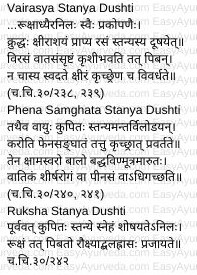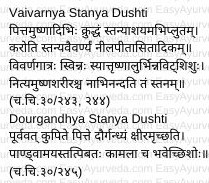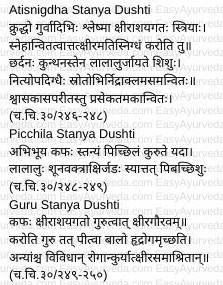Breast Milk Disorders: Symptoms, Detoxification, Remedies
Breast milk is the prime source of nourishment to a new born child. Feeding breast milk to a new born improves the strength and immunity of the baby. As per Ayurveda, mother’s food and activities affect the quality of the milk. If mother indulges in unwholesome diet and lifestyle habits, then the milk gets vitiated, in turn leading to diseases in the children. The vitiated milk is explained as ‘Dooshita Stanya’ in Ayurveda.

In such cases along with the child care, mother’s health also should be checked with due emphasis. In Ayurveda, certain herbs and medicines are specifically indicated for detoxifying the breast milk.
Read: Ayurvedic Post Natal Care – The First Week After Delivery
Table of Contents
Causative factors
Reasons for vitiation of Stanya dushti (Breast milk):
Ajeernashana – consuming food when the person is suffering from indigestion.
Asatmya bhojana – unwholesome food – wrong food combination
Vishamashana (improper food intake) – taking food when person is not hungry.
Viruddhashana (incompatible food)
Atyartha bhojana (heavy food intake)
Lavana-amla-katu-kshara anna bhojana (excess intake of salty-sour-pungent and alkaline food)
Mana shareera santapa (factors causing stress and strain to the body and mind)
Nishi aswapna (night awakening)
Chintana (grief)
Vega prateeghata (suppression of the urges)
Vega udeerana (forcible initiation of the urges)
Guda krita paramanna (kheer prepared by the jaggery)
Krishara (kichdi)
Mandaka dadhi (wrongly formed curd)
Abhishyandi ahara (sticky food causing blockage of the channels)
Gramya anupa oudaka mamsa (flesh of the deserts,marshy land and aquatic animals)
Diwaswapna (day sleep)
Madyapana (alcohol intake)
Abhighata (injury)
Roga karshana (chronic diseases) etc.
Read: After Delivery Care Of Mother For First Three Months By Ayurveda
Features of breast milk vitiation
Features of vitiated breast milk (Stanya dushti):
Breast milk vitiation due to Vata dosha – Vataja Stanya Dushti:
Vataja Stanya Dushti
Features of milk
Breast milk will have bluish black or pink tinge, possesses astringent taste, appears watery, loses taste gradually, dry, light and frothy in nature. The child will not be satisfied by its intake.
Disease features in the child
Reduced voice, lean body parts/dystrophy, constipation, dysuria and bloating, gas distention.
Pittaja Stanya Dushti
Features of milk- Breast milk will have black, blue or coppery tinge, possesses bitter-sour or pungent taste, bad-bloody odours and warm. It will cause burning sensation,ulceration and other such paittic disorders.
Disease features in the child- Excessive sweating, diarrhoea, jaundice, thirst, warmth of the body (pyrexia).
Kaphaja Stanya Dushti
Kapha vitiation of breast milk:
Features of milk-Breast milk will be pale,more sweet,possesses more sweet taste or appears salty. It resembles like the ghee, oil, muscular fat or marrow and slimy in nature. Appears thready too.
Disease features in the child- Excess salivation, kaphaja disorders, excessive sleep, stiffness, laziness, vomiting and swelling in the face, eyes and extremities.
Tridoshaja Stanya Dushti
Tridosha vitiation: Mixed features.
Read: Ayurvedic Post Natal Mother Care Based On Season And Place
Ayurvedic medicines
Medication for Vitiation of Breast milk:
Vata breast milk vitiation:
The decoction prepared out of
Devadaru – Cedrus deodara
Katukarohini – Picrorhiza kurroa
Vacha – Acorus calamus
Kushtha – Saussurea lappa
Patha – Cyclea peltata
Bharngi – Clerodendron serratum
and ginger is administered to the mother.
If all the herbs are not available, at least a few herbs from the list can be selected for making Kashaya.
Ayurvedic medicines for Vataja Stanya Dushti:
Devadarvadi kashaya
Pushyanuga choorna
Dashamoola ghrita
Kakolyadi kashaya
Mashatmaguptadi kashaya
Shunti ksheerapaka – 10 grams ( 2 teaspoons) of ginger powder is mixed with 80 – 100 ml (3 ounce) of milk and 100 ml of water. Boiled till only 100 ml (~3 ounce) remains. Filtered. This is given in a dose of 25 ml, once or twice a day after food.
Pitta breast milk vitiation:
The decoction prepared out of
Giloy,
Patola – Pointed gourd
Anantamoola – Hemidesmus indicus
Shatavari – Asparagus racemosus
Nimba – neem and
Chandana – Sandalwood is administered to the mother.
2.Fine powder or decoction of
Triphala,
Kiratatikta – Swertia chirata
Katukarohini or
Musta – Cyperus rotundus is also useful.
Ayurvedic medicines for Pittaja Stanya Dosha:
Guduchi satwa
Shatavari rasayana
Triphala ghrita
Padmakadi kashaya
Sarivadi hima
Kaphaja breast milk vitiation:
1.The decoction prepared out of
Musta – Cyperus rotundus
Vacha – Acorus calamus and
Ativisha – Aconitum heterophyllum
or
kashaya prepared from –
Indrayava – Seeds of Kutaja
Tagara and
Krishna jeeraka – Black cumin should be given to the mother.
Ayurvedic medicines useful in Kaphaja Stanyadosha:
Sannipatic (All three Doshas) breast milk vitiation:
The decoction of Musta, Patha, Ativisha, Kushtha and Katukarohini is administered to the mother and child.
The decoction of Kiratatikta,Guduchi, Indrayava and Anantamoola is also useful.
Formulations-
- Vachadi yoga
- Pathadi choorna
- Chaturbhadra kashaya
- Rasnadi kashaya
Instructions to mother
If your Ayurvedic doctor has suggested medicines for breast milk detoxification, you can still continue to feed the baby while on medication.
It is always better to have a positive lifestyle with
– good amount of exercise,
– avoiding sitting at a single place for a long period of time,
– eating only when hungry,
– avoiding junk foods, smoking and alcohol etc.
Include a good amount of turmeric, ginger, cinnamon, cardamom and curry leaves in your diet.
Apart from physical activities, even mental status and habits of mother also have a great influence over the baby. Hence, stay positive, have constructive hobbies, be active, avoid excess TV and internet, do Pranayama and Yoga.
As the childcare needs very precise information about the food and habits of the mother as well as the child, it is very essential to watch the daily routines of both the individuals. Even the minute changes are to be corrected immediately as the health of the child is a very delicate issue. Altered lifestyle now a days shows its immediate effect over the child. Cre and caution in this regard surely helps to prevent many childhood diseases.
Article by Dr MS Krishnamurthy and Dr Hebbar
Eight Disorders Of Breast Milk – Ashta Kshira Dosha
By Dr Raghuram Y.S. MD (Ay) & Dr Manasa, B.A.M.S
Master Charaka has described 8 diorders of milk based on the appearance of the breast milk contaminated by one or the other dosha. The appearance of the milk on the other hand will give the physician a gross clue so as to which dosha is involved in the causation of that particular disorder.
Read – Human Breast Milk Benefits, Ways To Increase Production

The eight disorders of milk are as below mentioned
| Sl No | Name of the breast milk disorder | Characteristic / Appearance | Dosha predominance |
| 1 | Vairasya | Tasteless | Vata |
| 2 | Phena samghata | Frothy / froth mixed | Vata |
| 3 | Roukshya | Dryness (devoid of unctuousness) | Vata |
| 4 | Vaivarnya | Discoloration | Pitta |
| 5 | Dourgandhya / Vaigandhya | Foul smelling | Pitta |
| 6 | Atisneha | Excessively unctuous | Kapha |
| 7 | Paicchilya | Slimy / sticky | Kapha |
| 8 | Gauravam | Heaviness | Kapha |

A. Breast disorders caused by vitiated vata
1. Altered taste – Vairasya Stanya Dushti
i. Causes –
- excessive consumption of foods which are vata vitiating and dry in nature
- activities which aggravate vata
ii. Pathogenesis –
The vata aggravated by one or more of the above mentioned causes will reach the breasts and get lodged therein. Vata vitiates the breast milk and bring about change in its taste. As a result the normal sweet taste of milk would get influenced and becomes tasteless.
iii. Symptoms –
The child drinking such tasteless breast milk will develop one or the other below mentioned conditions –
- Krishi bhavati – The child gets emaciated
- Na cha asya svadate kshiram – The child does not feel taste of milk
- Kricchrena vivardhate – There is slow and difficult growth and development of the child
Read – Symptoms That Hint Towards Different Diseases In Babies
iv. Treatment
a. Internal Medication
Drakshadi Churna – the fine powder of the below mentioned ingredients should be given mixed in warm water –
- Draksha – Vitis vinifera
- Madhuka – Glyzirrhiza glabra
- Sariva – Hemidesmus indicus
- Payasya – Ipomoea digitata
b. External Medication
Panchakoladi Lepam – the powders of Panchakola and horse gram should be pestled, made into a paste and applied over the breasts. Once the paste gets dried, it should be washed off. Later the milk should be expressed out of the breasts properly. In this way the breast milk gets purified.
Read – Breast Milk Detoxification Based On Dosha
2. Excess frothing – Phena Samghata Stanya Dushti
i. Causes – same as those of Vairasya Stanya Dushti
ii. Pathogenesis –
The vata aggravated by one or more of the above mentioned causes will reach the breasts and get lodged therein. The vata then churns the breast milk. Froth develops due to the milk being churned by the vitiated vata. This type of breast milk gets discharged / ejected with difficulty.
iii. Symptoms –
The child drinking such frothy breast milk will develop one or the other below mentioned conditions –
- Kshama svaro balo – the child sucking this type of frothy milk would have weak cry
- Baddha vin-mutra-marutah – there is obstruction of feces, urine and flatus
- Vatika shirsha roga – the child suffers from head disorders of vata origin
- Pinasam – the child may suffer from chronic rhinitis
Read – Symptoms Of Vata Dosha Increase And Imbalance – Vata Vruddhi Lakshana
iv. Treatment
a. Internal medication
Pathadi Kalka – paste of the below mentioned herbs should be administered mixed in lukewarm water –
- Patha – Cissampelos pareira
- Nagara – Zingiber officinale
- Sharngesta – Dregea volubilis
- Murva – Marsdenia tenacissima
Kiratatiktadi Kwatha – the decoction prepared with the below mentioned herbs is useful –
- Kiratatikta – Swertia chirata
- Ginger
- Amrta – Tinospora cordifolia
b. External medication
Anjanadi Lepa – The paste of the below mentioned herbs should be applied over the breasts –
- Anjana – extract of Berberis aristata
- Nagara – Zingiber officinale
- Daru – Cedrus deodara
- Bilva Mula – roots of Aegle Marmelos
- Priyangu – fruits of Callicarpa macrophylla
When the paste gets dried it should be washed off and the milk should be squeezed out.
Yavadi Lepa – Similarly the paste of the below mentioned shall be applied over the breasts. When it gets dried it shall be washed off and the milk squeezed out from the breasts.
3. Excess dryness – Ruksha Stanya Dushti
i. Causes – same as those of Vairasya Stanya Dushti
ii. Pathogenesis –
The vata aggravated by one or more of the above mentioned causes will reach the breasts and get lodged therein. Following this vata desiccates and depletes the fatty substances of the milk. As a result the breast milk becomes devoid of unctuousness.
iii. Symptoms –
Bala hrasa – the child consuming such dry and non-unctuous milk would suffer from loss of energy.
iv. Treatment
a. Internal medication
Pathadi Dugdha – milk processed with patha etc breast purifying herbs should be served for drinking. They are –
- Patha – Cissampelos pareira
- Mahaushadha – Zingiber officinale
- Suradaru – Cedrus deodara
- Musta – Cyperus rotundus
- Murva – Marsdenia tenacissima
- Guduchi – Tinospora cordifolia
- Vatsaka phala – Holarrhena antidysenterica
- Kiratatikta – Swertia chiraita
- Katukarohini – Picrorhiza kurroa
- Sariva – Hemidesmus indicus
b. External medication
Luke warm paste of the below mentioned herbs should be applied over the breasts –
- Jivaka etc 10 herbs belonging to Jivaniya Gana group of herbs
- Panchamula
When the paste gets dried it should be washed off. Following this, the milk should be extracted / expressed from the breasts.
Read – Stanya Janana Gana: Lactation Promoting Herbs: Review, Benefits, Formulations

B. Breast disorders caused by vitiated pitta
4. Discoloration – Vaivarnya Stanya Dushti
i. Causes –
- excessive consumption of foods which are hot in nature
- excessive consumption of pitta vitiating foods (having qualities which can vitiate pitta)
- activities which tend to disturb and aggravate pitta
- any pitta vitiating causes
ii. Pathogenesis –
The pitta aggravated by one or more of the above mentioned causes will reach the breasts and get lodged therein. Later this pitta produces blue, yellow, black etc abnormal colors in the milk. There occurs discoloration of the breast milk due to the impact of vitiated pitta and hence the name.
iii. Symptoms –
The child drinking such discolored breast milk will develop one or the other below mentioned conditions –
- Vivarna Gatrah – the child sucking this discolored milk would suffer from the discoloration of the body
- Swinna – excessive sweating
- Trushnalu – excessive thirst,
- Bhinna vit – diarrhea
- Nityam ushna shariram – the body of the child is always hot
- Na abhinandati stanam – the child shows no desire to suck the breasts
iv. Treatment
a. Internal Medication
Yashtyadi Kalka – Paste of the below mentioned ingredients should be mixed with water and given to drink –
- Yashtimadhu – Glycyrrhiza glabra
- Mrdvika – Vitis vinifera
- Payasya – Ipomoea digitata
- Sindhuvarika – Vitex negundo
b. External Medication
Drakshadi Lepa – Paste of Draksha – Vitis vinifera and Madhuka – Glycyrrhiza glabra should be applied over the breasts. When it gets dried up it should be washed off. Following this, the milk should be repeatedly expressed.
Read – Pitta Increase Symptoms – Pitta Vriddhi Lakshana
5. Bad Odor – Dourgandhya Stanya Dushti
i. Causes – same as those mentioned for Vaivarnya Stanya Dushti
ii. Pathogenesis –
The pitta aggravated by one or more of the above mentioned causes will reach the breasts and get lodged therein. Later this pitta produces foul smell in the breast milk.
iii. Symptoms –
The child drinking such foul smelling breast milk will develop one or the other below mentioned conditions –
- Pandu – anemia
- Kamala – jaundice
iv. Treatment
a. Internal Medication
Vishanikadi Kalka – The paste of the below mentioned herbs should be given with cold water –
- Vishanika – Pistacia chinensis
- Ajasringi – Gymnema sylvestre
- Triphala – powder of fruits of Terminalia chebula, Terminalia bellirica and Emblica officinalis
- Rajani – Curcuma longa
- Vacha – Acorus calamus
Abhayadi Churna – powder of Abhaya – Terminalia chebula and Vyosa – Piper longum, Piper nigrum and Zingiber officinale mixed with honey should be administered.
The wet nurse / mother should use congenial diet.
b. External Medication
Sarivadi Lepa – the paste of the below mentioned herbs should be applied over the breasts. Once the paste dries up it should be washed off and the milk extracted.
- Sariva – Hemidesmus indicus
- Ushira – Vetiveria zizanioides
- Manjishtha – Rubia cordifolia
- Sleshmataka – Cordia dichotoma
- Kuchandana – Adenanthera pavonina / Caesalpinia sappan
Patradi Lepa – Similarly the paste of the below mentioned should be applied on the breasts –
- Patra – Cinnamomum tamala
- Ambu – Cyperus rotundus
- Chandana – Santalum album
- Ushira – Vetiveria zizanioides

B. Breast disorders caused by vitiated kapha
6. Excess unctuousness – Atisnigdha Stanya Dushti –
i. Causes –
- excessive consumption of foods which are heavy to digest in nature
- excessive consumption of kapha vitiating foods (having qualities which can vitiate kapha)
- activities which tend to disturb and aggravate kapha
- any kapha vitiating causes
ii. Pathogenesis –
The kapha aggravated by one or more of the above mentioned causes will reach the breasts and get lodged therein. Later this kapha makes the breast milk excessively unctuous by its unctuous property.
iii. Symptoms –
The child drinking such excessively unctuous breast milk will develop one or the other below mentioned conditions –
- Chardi – vomiting
- Kunthanam – tenesmus / straining at defecation
- Lalalu – excessive salivation
Since the channels are constantly smeared, covered or clogged by excessive unctuousness of kapha leading to excessive unctuousness of the breast milk, the child suffers from one or more of the below mentioned conditions –
- Nidra – excessive sleep
- Klama – excessive tiredness
- Shvasa – dyspnea
- Kasa – cough
- Praseka – excessive expectoration
- Tama – feel of darkness in front of the eyes
Read – Kapha Increase Symptoms – Kapha Vruddhi Lakshana
iv. Treatment
a. Internal Medication
Darvadi Kalka – paste of the below mentioned herbs should be administered with lukewarm water –
- Tree Turmeric – Daru – Cedrus deodara
- Musta – Cyperus rotundus
- Patha – Cissampelos pareira
- Saindhava – Rock Salt
7. Excess stickiness – Picchila Stanya Dushti
This condition is caused by vitiation of breast milk predominantly by vitiated kapha.
i. Causes – same as the causes mentioned for Atisnigdha Stanya Dushti
ii. Pathogenesis –
The kapha aggravated by one or more of the above mentioned causes will reach the breasts and get lodged therein. Later this kapha overpowers the breast milk and makes it excessively slimy.
iii. Symptoms –
The child drinking such excessively slimy breast milk will develop one or the other below mentioned conditions –
- Lalalu – excessive salivation
- Shuna vaktra – edema of face
- Shuna akshi – swelling of eyes
- Jadata – dullness
iv. Treatment
a. Internal Medication
Sarngeshtadi Kalka – paste of the below mentioned herbs should be administered with lukewarm water –
- Sarngeshta – Dregea volubilis
- Chebulic myrobalan – Abhaya – Terminalia chebula
- Vacha – Acorus calamus
- Nut Grass – Musta – Cyperus rotundus
- Ginger – Nagara – Zingiber officinale
- Patha – Cissampelos pareira
Takrarishta – Use of takrarishta recipe prescribed for diseases of piles and diseases of anus / rectum are also beneficial in this condition.
b. External Medication
Vidaryadi Lepa – the paste of the below mentioned herbs should be applied on the breasts. When the paste gets dried it should be washed off.
- Vidarikanda – Pueraria tuberosa
- Bael – Bilva – Aegle marmelos
- Licorice – Madhuka – Glycyrrhiza glabra
Read – 3 Traditional Remedies To Dry Up Breast Milk

8. Excess heaviness – Guru Stanya Dushti
i. Causes – same as the causes mentioned for Atisnigdha Stanya Dushti
ii. Pathogenesis –
The kapha aggravated by one or more of the above mentioned causes will reach the breasts and get lodged therein. Later this kapha due to its own heaviness quality makes the breast milk excessively heavy.
iii. Symptoms –
The child drinking such excessively heavy breast milk will develop one or the other below mentioned conditions –
- Hridroga – cardiac disorders
- Anyan cha vividhan rogan – many other disorders of milk
iv. Treatment
a. Internal Medication
Trayamanadi Kashayam – decoction of the below mentioned herbs shall be served –
- Trayamana – Gentiana kurroo
- Indian Tinospora – Amrta – Tinospora cordifolia
- Neem – Nimba – Azadirachta indica
- Patola – Trichosanthes dioica
- Triphala – Terminalia chebula, Terminalia bellirica and Emblica officinalis
Pippalimuladi Kwatha – decoction of the below mentioned herbs is also useful in treating this condition –
- Long pepper root – Pippalimula – roots of Piper longum
- Chavya – Piper retrofractum
- Leadwort – Chitraka – Plumbago zeylanica
- Ginger – Nagara – Zingiber officinale
b. External Medication
The paste of the below mentioned herbs shall be applied over the breasts –
- Bala – Sida cordifolia
- Ginger – Nagara – Zingiber officinale
- Sarngestha – Dregea volubilis
- Murva – Marsdenia tenacissima
Prisniparnyadi Lepa – paste of Prisniparni – Uraria picta and Payasya – Ipomoea digitata shall be applied over the breasts.
Click to Consult Dr Raghuram Y.S. MD (Ayu)








